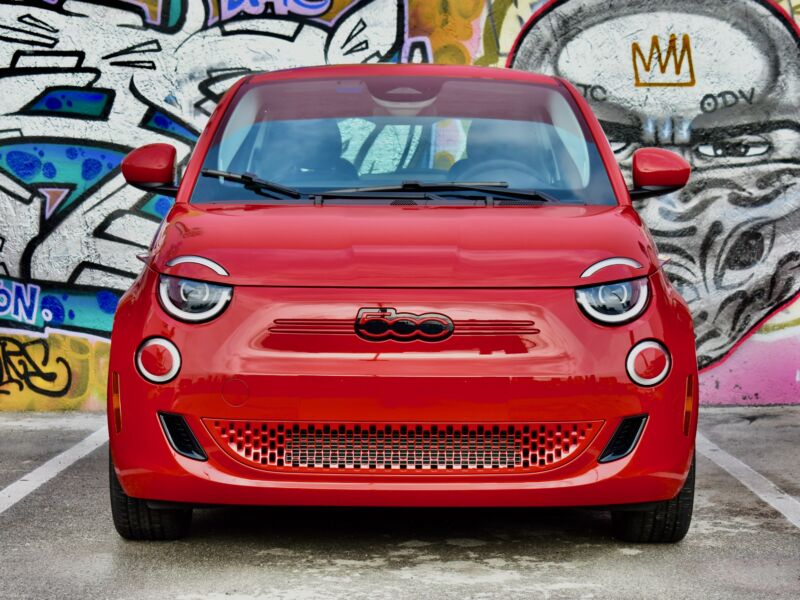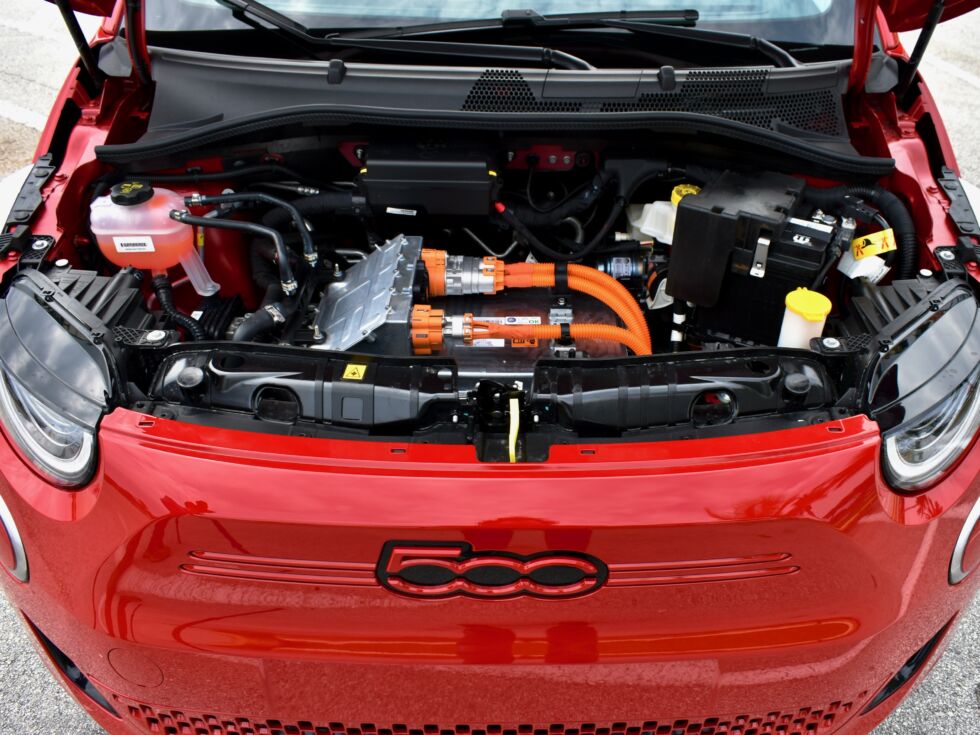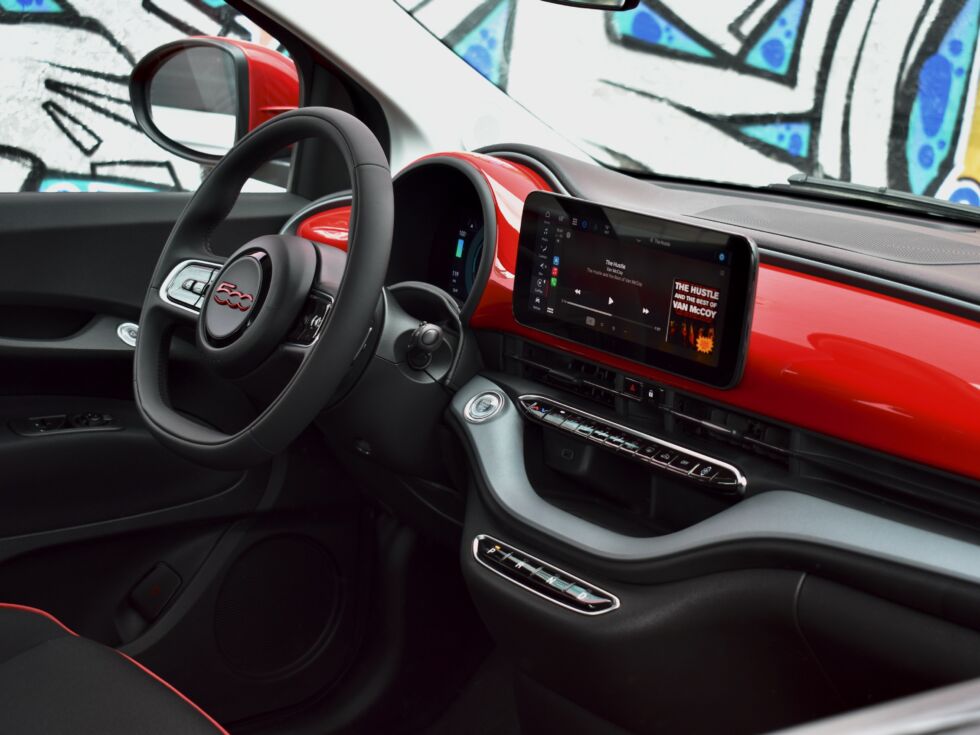
It's cliché to describe an Italian automaker as operating on a slower, more laid-back timetable than its rivals, but that seems to be the case with Fiat's North American product planning.
The outgoing Fiat 500 brought the brand back to the United States in 2011, but it had been on sale in Europe since 2007. An electric 500e arrived after the gasoline models, but as then-CEO Sergio Marchionne was quick to point out, that was only to satisfy California's zero-emission vehicle mandate.
Now the 500e is back, once again later than the European version (which was first shown in 2020), but this time, Fiat is skipping the gasoline engines for the line. The 2024 Fiat 500e is no compliance car—it's now the only version of this retro hatchback you can get and the only Fiat model available in the US—nor is it a mass-market item.
"My ambition is not to replace your sedan or [S]UV," Fiat CEO Olivier Francois said in a presentation during a 500e drive program in Miami. The new 500e was designed with the same ethos as its predecessor. It is intended to be a stylish second car (Francois calls it the "ultimate fashion accessory"), sharing garage space with something more practical.

That once again puts the 500e in the competitive crosshairs of the modern Mini, which gets redesigned gasoline and all-electric variants for the 2025 model year. But the Fiat's styling has stayed closer to its inspiration than Mini's, which seems to have lost the plot. The rounded two-box shape remains, along with the distinctive "face" created by the grille-less, flat front end. New headlights with eyelash-like upper elements give that face a somewhat disapproving look, though. Engineers also tried to tidy up airflow with a few subtle features, including recessed door handles borrowed from Maserati.
AdvertisementThe 500e rides on a new EV-specific platform called STLA City, which led to some changes in proportions. The new model is 2.4 inches (60 mm) longer and 2.2 inches (55 mm) wider than its predecessor, with a 0.87-inch (22 mm) longer wheelbase.
Fiat claims the new platform allowed the seating position to be lowered, avoiding the barstool-like feel of the old 500. The driving position did indeed feel a bit more normal, and the fairly short hood and generous side glass enhanced outward visibility. Rear seats are included, but they're only useful as additional cargo space, which is more generous than you might think. But because the motor and other hardware live under the hood, there's no frunk.
The interior has a pleasingly simple design, although aside from the red dashboard fascia in our 500e (RED) launch model (so named because of a tie-in with the RED charity), materials seemed more appropriate for a bargain-basement econobox than a vehicle marketed as a chic fashion accessory on wheels.

Fiat also kept things simple in the mechanical department. The 500e uses a 42-kWh battery pack that affords 149 miles (240 km) of range. That's perhaps not the number some EV shoppers want to see, but Fiat notes that it's more than enough for the roughly 30 miles (48 km) of daily driving most Americans do.
A smaller pack also costs less, uses fewer raw materials, and helps save weight. At just under 3,000 lbs (1,360 kg), the 2024 500e is 50 lbs (23 kg) lighter than the previous-generation 500e. That's pretty impressive, considering that a gasoline 2025 Mini Cooper S is expected to weigh 3,014 lbs (1,367 kg) and the 500e has a battery pack under the floor.
A 100 percent charge from a Level 2 AC source takes six hours, so cars won't even need a full overnight charging session, while 85 kW DC fast charging can finish a 0–80 percent charge in 35 minutes. Fiat will offer customers a choice of public charging credits or a free home wallbox unit (installation costs not included).
The powertrain is modest as well. A single electric motor sends 117 hp (87 kW) and 162 lb-ft (220 Nm) of torque to the front wheels, getting the 500e from zero to 60 mph in a Fiat-estimated 8.5 seconds and up to a top speed of 94 mph (151 km/h). While the original 500 had its engine in the back, powering the rear wheels, the 500e retains the front-wheel drive layout of the previous modern 500 to preserve its distinctive proportions and maintain rear cargo space, according to Fiat.

Acceleration is peppy, with the motor pulling more strongly at low speeds and gradually leveling off in accelerative effort. Full power is available in the Normal and Range drive modes, but Fiat also includes a Sherpa mode that limits the 500e to 76 hp (57 kW) while capping the top speed at 50 mph (80 km/h) and disabling the climate control to stretch range. The 500e didn't feel like a liability in this mode, and full power is still available via an accelerator pedal kickdown switch, but we'd only use it if we were desperate.
AdvertisementSherpa and Range modes also dial up regenerative braking to its maximum, allowing for one-pedal driving. And the Fiat's front-wheel drive layout lets drivers make the most of regen, as most of the braking force in any car is applied to the front wheels. In the 500e's case, Normal mode is meant to replicate the feel of an internal-combustion car with minimal regenerative braking.
Our test drive was limited to stop-and-go traffic on the streets of Miami, but it was at least a reminder of how handy a small car like this can be if you live in a place like that. The steering's lack of feel would have probably made the 500e less than fun on a twisty road, but the Fiat's smallness lent it confidence-inspiring agility while slaloming through slow traffic. And there aren't many cars of this size currently available in the US, electric or otherwise.
With few corners available on our test route, it was difficult to judge the 500e's cornering competence. But the suspension at least provided a comfortable ride, easily absorbing impacts from potholes and steel road plates. The overall character felt right for a standard 500. This car is small and agile, but it's not in a hurry to get anywhere. Fiat's Abarth performance sub-brand can handle sportiness.

The driving experience maintains the status quo, then, but the technology suite reflects the pace of development since the previous-generation 500e was designed. A 10.25-inch touchscreen and 7.0-inch digital instrument cluster are both standard. Stellantis' ubiquitous Uconnect 5 infotainment system makes another appearance here, augmented by wireless Apple CarPlay and Android Auto, natural language voice recognition, and over-the-air (OTA) firmware updates.
A decent array of driver aids is standard on the RED launch model, including automatic emergency braking, traffic sign recognition, and lane keep assist. Adaptive cruise control, with highway lane centering provided by the lane-keep assist system, will be available on the Inspired By Music and Inspired By Beauty models launching later this year.
As hinted by the unusual names, Fiat isn't doing traditional trim levels with the 500e. New models will arrive as "drops" two to three times a year, with some styling differences but broadly the same equipment and specs. Fiat says this release plan was inspired by the fashion industry, but it also seems a bit like the periodic special editions automakers launch to maintain interest in unchanged models. Potentially more significant is Fiat's plan to sell the 500e online, albeit in partnership with its existing franchised dealerships.
The Fiat 500e (RED) arrives first. Cars have already been shipped to the United States from the Mirafiori, Italy, factory that builds the 500e and some Maseratis, with a base price of $34,095 with destination. Inspired by Music and Inspired by Beauty models are available to order now starting at $37,595, with deliveries scheduled to start in the third quarter of this year.
- The 500e maintains its traditional two-box shape.Stephen Edelstein
- The minimalist driver display.Stephen Edelstein
- The uConnect infotainment screen.Stephen Edelstein
- The J3400 (NACS) charge port is coming to Fiat EVs, but not until model year 2026.Stephen Edelstein
- The styling is muscular, but the handling is not very sporty.Stephen Edelstein
That pricing makes the 500e one of the least expensive new EVs available in the US, but that's more a reflection of the current lack of affordable models than this Fiat's value proposition. For $37,285, you could have a Nissan Leaf SV Plus with usable rear seats and an EPA-rated 212 miles (342 km) of range. That would be the logical thing to do, but appealing to logic isn't the point of the 500e.
AdvertisementThis little Fiat remains a niche vehicle of the kind that's increasingly being swept aside in an auto industry homogenizing around crossover SUVs and the active-lifestyle fantasies they portray. The 500e appeals to new car buyers who have fallen for its adorable styling and the romance of owning an Italian car and are willing to admit they won't be taking road trips in it or stuffing it full of recreational gear.
Stellantis' planned North American EV lineup already has plenty of variety, encompassing models ranging from the retro Dodge Charger Daytona to the Jeep Recon off-roader. But where these EVs promise buyers more capability than they need, the 500e makes trade-offs to fill its niche. That makes for a much tougher sales pitch, so it's remarkable that Stellantis brought the 500e back to the US at all. But buyers looking for a small, basic EV with personality will be glad it did.
















